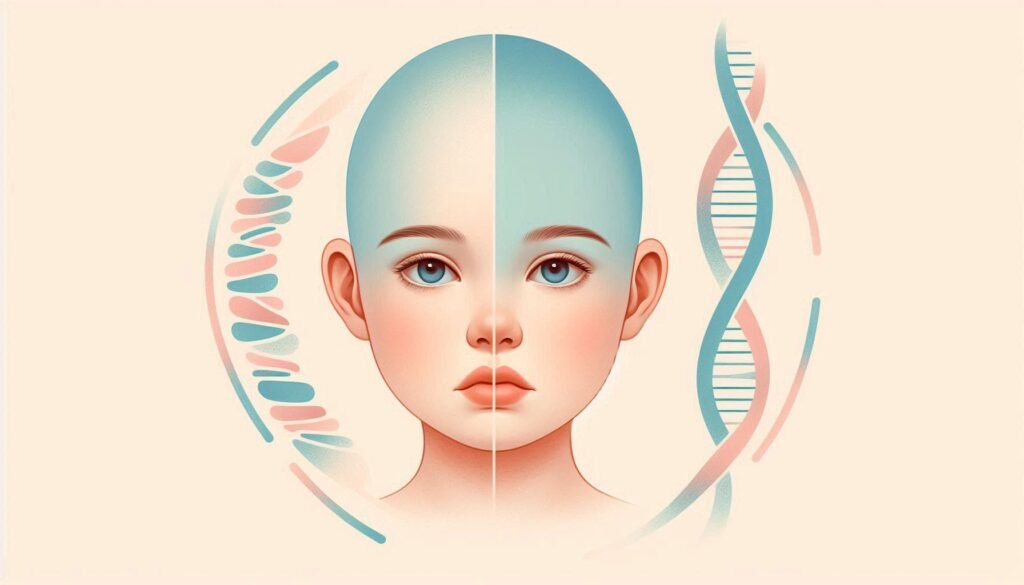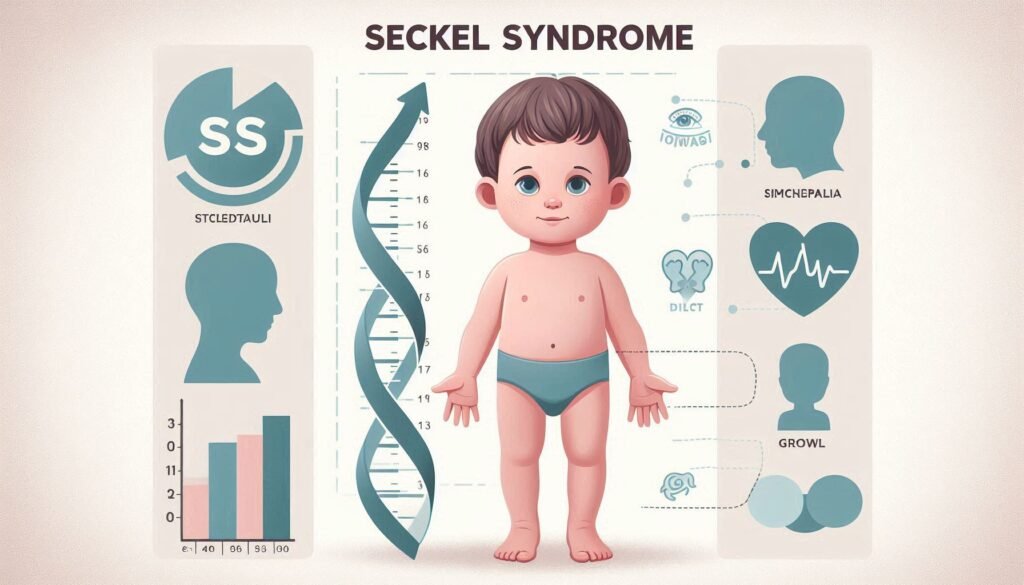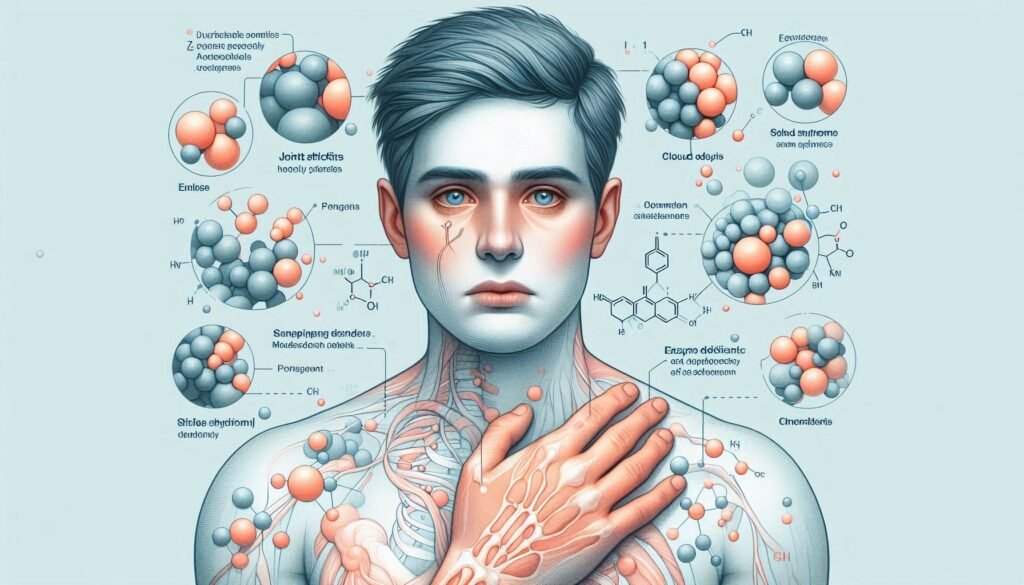Saethre-Chotzen Syndrome is a rare craniofacial disorder that can significantly impact the lives of those affected. Characterized by unique physical features and varying degrees of developmental challenges, this syndrome often leaves patients and their families seeking answers. Understanding Saethre-Chotzen Syndrome goes beyond just recognizing its symptoms; it involves delving into its genetic roots, historical context, and potential treatment options.
Through this comprehensive guide, we will explore what makes Saethre-Chotzen Syndrome distinctive. Whether you’re a parent navigating this complex condition or simply interested in learning more about craniofacial disorders, you’ll find valuable insights here. Join us as we unravel the intricacies of Saethre-Chotzen Syndrome to foster awareness and understanding around this fascinating yet challenging health issue.

What is Saethre-Chotzen Syndrome? Understanding the Basics
Saethre-Chotzen Syndrome is a genetic disorder that primarily affects craniofacial development. It is classified as a type of craniosynostosis syndrome, meaning it results from the premature fusion of skull bones.
Individuals with this condition often exhibit distinctive facial features, such as asymmetry and an unusual shape to the head. Other physical characteristics can include low-set ears and eyelid abnormalities.
“What Causes ARDS (Acute Respiratory Distress Syndrome)? Complete Guide”
The severity of symptoms varies significantly among those affected. While some may experience minor issues, others face more significant challenges related to their appearance and health.
This syndrome is caused by mutations in the TWIST1 gene, which plays a crucial role in bone formation and development. Understanding these basics lays the groundwork for further exploration into its implications on health and well-being.
Historical Context: Haakon Saethre, F. Chotzen, and the Syndrome’s Discovery
Saethre-Chotzen Syndrome is named after two pioneering figures in the field of genetics. Haakon Saethre, a Norwegian physician, first identified this craniofacial disorder in 1931. He noted distinct physical features that characterized affected individuals, laying the groundwork for further research.
“How Does Adams-Oliver Syndrome Affect Development? Expert Explained”
Fritz Chotzen, a German surgeon, later contributed to our understanding of the syndrome. In 1938, he published findings that highlighted additional clinical manifestations and genetic implications. Together, their work brought attention to craniosynostosis syndromes and emphasized the importance of genetic factors.
Their collaboration marked significant advancements in recognizing the complexities associated with craniofacial disorders. This historical context emphasizes how foundational discoveries shaped current knowledge about Saethre-Chotzen Syndrome and encouraged ongoing research into its causes and effects on those affected.
Genetic Basis: The Role of TWIST1 Gene Mutations
Saethre-Chotzen Syndrome has a distinct genetic underpinning, primarily linked to mutations in the TWIST1 gene. This gene plays a crucial role in craniofacial development and tissue differentiation during embryonic growth.
“What Is Adie Syndrome & Why Does It Affect Your Pupils? Complete Guide”
When mutations occur in TWIST1, they disrupt normal cellular processes. As a result, this can lead to the characteristic features associated with Saethre-Chotzen Syndrome.
Notably, these mutations often follow an autosomal dominant inheritance pattern. This means that only one copy of the altered gene is sufficient for an individual to exhibit symptoms of the syndrome.
Genetic testing can confirm these mutations, offering clarity for affected families. Understanding the underlying genetics paves the way for better management strategies and insights into other related conditions.
Prevalence and Epidemiology: How Common is Saethre-Chotzen Syndrome?
Saethre-Chotzen Syndrome is considered a rare disorder. Estimates suggest that it occurs in approximately 1 in 50,000 births.
“Why Does Alice in Wonderland Syndrome Make Things Look Different? Guide”
This condition affects both genders equally and can be found across all ethnic backgrounds. However, due to its rarity, many healthcare professionals may not encounter it frequently.
The syndrome often goes undiagnosed or misdiagnosed early on since it shares features with other craniosynostosis syndromes. This can lead to challenges in understanding its true prevalence.
Research indicates that genetic factors play a significant role in the occurrence of Saethre-Chotzen Syndrome. Families with one affected individual have an increased likelihood of having another child with similar characteristics.
Ongoing studies aim to shed more light on its epidemiology and improve diagnostic rates for better patient outcomes.
Clinical Features: Recognizing the Characteristic Signs and Symptoms
Saethre-Chotzen Syndrome presents with a range of distinctive clinical features that can aid in its early recognition. The most notable signs often include craniosynostosis, where the skull bones fuse prematurely, leading to an abnormal head shape.
“What Causes Alien Hand Syndrome? Understanding This Rare Brain Condition”
Facial asymmetry is another characteristic trait. Individuals may have uneven facial structures, particularly around the eyes and forehead. Additionally, eyelid abnormalities such as ptosis (drooping) are common.
Hearing loss can also be observed due to ear malformations or associated middle ear issues. Limb anomalies frequently present as syndactyly, which involves fused fingers or toes.
Cognitive development typically falls within normal ranges; however, some children might experience learning difficulties related to their unique physical challenges. Early identification of these symptoms plays a crucial role in managing Saethre-Chotzen Syndrome effectively and enhancing overall quality of life for those affected.
Craniofacial Abnormalities: Specific Facial and Skull Deformities
Craniofacial abnormalities associated with Saethre-Chotzen Syndrome manifest in distinct facial and skull deformities. One of the most recognizable features is a prominent forehead, often accompanied by hypertelorism, which refers to widely spaced eyes.
“How Does Aarskog-Scott Syndrome Affect Male Development? Expert Guide”
Patients may also exhibit a beaked nose and low-set ears. These characteristics contribute to unique facial aesthetics that can vary significantly among individuals.
The skull itself may show signs of flattening or asymmetry due to premature fusion of cranial sutures, known as craniosynostosis. This can lead to increased intracranial pressure over time if not addressed.
Additionally, some individuals experience midface hypoplasia, resulting in an underdeveloped maxilla that affects overall facial balance and harmony. Understanding these specific traits helps healthcare providers tailor treatment plans for affected patients effectively.
Hand and Foot Anomalies: Understanding Limb Involvement
Individuals with Saethre-Chotzen Syndrome often exhibit various hand and foot anomalies. These limb abnormalities can range from subtle to more pronounced features, affecting function and appearance.
“What Is Abdominal Compartment Syndrome & Why Is It Emergency?”
One common manifestation is syndactyly, where two or more fingers or toes are fused together. This condition can complicate everyday tasks such as grasping objects or walking.
Another notable feature may include brachydactyly, characterized by shortened digits that may hinder dexterity. Additionally, some individuals experience polydactyly, which results in extra fingers or toes.
The severity of these anomalies varies greatly among affected individuals. Therefore, tailored approaches to treatment and therapy are essential for improving functionality and enhancing quality of life throughout development.
Monitoring the growth and development of limbs is crucial during childhood. Early intervention can play a significant role in addressing potential complications related to mobility and coordination skills as children grow older.
Diagnostic Criteria: How Saethre-Chotzen Syndrome is Identified
Identifying Saethre-Chotzen Syndrome involves a combination of clinical evaluation and genetic testing. Medical professionals start with a thorough physical examination, looking for characteristic features associated with the disorder.
Patients often present with specific craniofacial anomalies such as asymmetry in facial structure and prominent forehead. The presence of fused fingers or toes can also be significant indicators.
In addition to these physical signs, family history plays an essential role. Since this syndrome is typically inherited in an autosomal dominant pattern, it’s crucial to assess parental genetics.
Genetic tests are performed to confirm mutations in the TWIST1 gene. These tests provide definitive evidence supporting the diagnosis, allowing healthcare providers to tailor treatment options effectively based on individual needs.
Genetic Testing: The Importance of Molecular Diagnosis
Genetic testing plays a crucial role in diagnosing Saethre-Chotzen Syndrome. By identifying mutations in the TWIST1 gene, healthcare providers can confirm the presence of this craniofacial disorder.
Molecular diagnosis helps differentiate Saethre-Chotzen from other similar conditions. This distinction is vital for proper management and treatment planning.
Families benefit significantly from genetic counseling after testing. Understanding their genetic risk can aid future family planning decisions.
Additionally, early detection through genetic testing allows for timely interventions. These interventions enhance quality of life by addressing complications before they escalate.
With advancements in technology, non-invasive prenatal testing methods are becoming more available. Expecting parents can gain insights into potential risks even before birth.
This evolving field continues to provide hope and clarity for families affected by this syndrome through targeted research and studies aimed at improving outcomes.
Imaging Studies: The Role of CT and MRI in Diagnosis
Imaging studies are crucial for diagnosing Saethre-Chotzen Syndrome. Both CT (computed tomography) and MRI (magnetic resonance imaging) play significant roles in evaluating craniofacial abnormalities associated with this condition.
CT scans provide detailed images of the skull, allowing healthcare providers to identify any suture closures or deformities. These insights help assess the extent of craniosynostosis and plan for potential surgical interventions.
MRI complements CT by offering a view of soft tissues and brain structures. It can reveal neurological complications that may accompany the syndrome, such as increased intracranial pressure or malformations.
Together, these imaging techniques enhance diagnostic accuracy. They not only assist in identifying physical anomalies but also guide treatment strategies tailored to individual needs. This collaborative use of technology is vital for effective management of Saethre-Chotzen Syndrome.
Differential Diagnosis: Distinguishing from Other Craniosynostosis Syndromes
Differentiating Saethre-Chotzen Syndrome from other craniosynostosis syndromes is critical for accurate diagnosis and management. Several conditions share overlapping features, making careful evaluation essential.
Crouzon syndrome presents similar facial characteristics but often lacks the limb anomalies typical of Saethre-Chotzen. Additionally, Crouzon patients may experience more severe neurological complications due to premature fusion of skull bones.
Apert syndrome also resembles Saethre-Chotzen with prominent forehead and ocular issues. However, Apert typically includes syndactyly—fusion of fingers or toes—which isn’t a hallmark feature in all cases of Saethre-Chotzen.
Pfeiffer syndrome can further complicate the diagnostic picture due to its distinctive thumb and toe deformities alongside craniofacial changes.
Clinicians must conduct thorough assessments, including genetic testing and imaging studies, to ensure an accurate diagnosis while considering these differentiating factors. This approach aids in devising targeted treatment plans tailored to each specific condition’s needs.
Treatment Approaches: Managing Symptoms and Improving Quality of Life
Managing Saethre-Chotzen Syndrome involves a multi-disciplinary approach aimed at addressing various symptoms and enhancing quality of life. Treatment often begins with careful observation and routine evaluations by healthcare providers specializing in craniofacial disorders.
Surgical interventions play a crucial role in correcting craniofacial abnormalities. These procedures can improve both appearance and functionality, significantly impacting an individual’s self-esteem. Early intervention is essential for optimal outcomes.
Therapies such as physical therapy may assist in improving motor skills, while occupational therapy focuses on enhancing daily living activities. Supportive care from speech therapists can also be beneficial, particularly if there are communication challenges.
Psychological support is equally important. Families often benefit from counseling to navigate the emotional aspects associated with the syndrome. Connecting with support groups allows families to share experiences and resources, fostering a sense of community among those affected by Saethre-Chotzen Syndrome.
Surgical Interventions: Craniofacial Reconstruction Techniques
Surgical interventions for Saethre-Chotzen Syndrome often focus on craniofacial reconstruction. These procedures aim to correct skull shape and facial asymmetry, enhancing both function and appearance.
Techniques like cranioplasty are frequently used. This involves reshaping the skull to alleviate pressure on the brain caused by abnormal bone fusion. Surgeons may also perform fronto-orbital advancement, repositioning the forehead and eye sockets for improved aesthetics and vision.
Another critical aspect is addressing midface hypoplasia. Surgeons can utilize maxillary distraction osteogenesis to gradually elongate the upper jaw, allowing for more harmonious facial proportions.
Post-operative care is essential in these cases. Regular follow-ups help monitor recovery progress and ensure optimal outcomes. With advancements in technology, 3D imaging plays a pivotal role in planning surgeries tailored to individual patient needs, leading to more successful results over time.
Orthodontic and Dental Care: Addressing Oral Health Issues
Orthodontic and dental care is crucial for individuals with Saethre-Chotzen Syndrome. Many experience misaligned teeth and jaw discrepancies. These issues can lead to difficulties in biting, chewing, and speaking.
Regular dental check-ups are essential. A pediatric dentist familiar with craniofacial disorders can provide tailored care plans. Early interventions often help manage complications effectively.
Braces or other orthodontic appliances may be necessary to correct alignment problems as the child grows. This process not only improves functionality but also enhances aesthetics, boosting self-esteem over time.
Additionally, oral hygiene becomes a primary concern due to structural anomalies that may trap food particles and plaque. Specialized techniques like using interdental brushes or water flossers can aid in maintaining cleanliness.
Parents should work closely with specialists to monitor dental development throughout childhood and adolescence for optimal outcomes in overall health.
Ophthalmological Management: Treating Eye-related Complications
Ophthalmological management is crucial for individuals with Saethre-Chotzen Syndrome. This craniofacial disorder can lead to various eye-related complications, including strabismus and ptosis.
Regular eye examinations are essential to monitor vision and detect any abnormalities early on. An ophthalmologist may recommend corrective measures such as glasses or contact lenses to help improve visual acuity.
In cases of strabismus, surgical intervention might be necessary to align the eyes properly. Addressing this issue can significantly enhance depth perception and overall quality of life.
Moreover, eyelid surgery may be indicated for patients experiencing ptosis. This procedure helps ensure that the upper eyelids do not obstruct vision, allowing for better function in daily activities.
Collaboration between healthcare providers is vital in managing these conditions effectively. A multidisciplinary approach ensures comprehensive care tailored to each patient’s unique needs.
Neurological Considerations: Monitoring and Managing Intracranial Pressure
Individuals with Saethre-Chotzen Syndrome often face unique neurological challenges. One significant concern is the management of intracranial pressure (ICP). Due to craniofacial abnormalities, patients may experience restricted skull growth or abnormal brain development.
Regular monitoring of ICP is crucial. Increased pressure can lead to severe complications, including headaches and cognitive impairments. Neurologists typically recommend routine imaging studies such as MRI or CT scans to assess brain structure and detect any changes in pressure levels.
When elevated ICP is identified, treatment options are available. Medications like diuretics can help reduce fluid accumulation, while surgical interventions might be necessary for more severe cases. These procedures aim to relieve pressure by creating additional space within the skull.
Careful observation and proactive management ensure that neurologic health remains a priority for individuals living with this syndrome. Working closely with healthcare professionals leads to better outcomes and improved quality of life for patients.
Living with Saethre-Chotzen Syndrome: Psychosocial Aspects and Support
Living with Saethre-Chotzen Syndrome involves navigating various psychosocial challenges. Individuals often face unique hurdles that can affect their self-esteem and social interactions.
Support from family, friends, and healthcare providers is vital. Understanding loved ones can create a nurturing environment that fosters confidence. Open conversations about the syndrome help demystify it for those around them.
Access to support groups plays a crucial role too. Sharing experiences with others facing similar challenges can foster camaraderie and reduce feelings of isolation. These communities provide emotional backing and practical advice on coping strategies.
Education also matters significantly in this journey. Awareness programs aimed at schools and workplaces encourage inclusivity, reducing stigma associated with craniofacial differences.
Mental health resources should not be overlooked either. Counseling services tailored to individuals with rare syndromes ensure that psychological well-being remains a priority throughout life’s ups and downs.
Long-term Prognosis: Development and Life Expectancy
The long-term prognosis for individuals with Saethre-Chotzen Syndrome varies widely. Many affected patients lead fulfilling lives, but they may face unique challenges due to associated health issues.
Developmental milestones can be delayed in some cases. Early intervention through therapies and educational support often plays a crucial role in enhancing developmental outcomes.
Life expectancy generally aligns closely with the general population, assuming proper medical care is obtained. Regular monitoring of potential complications helps ensure that any arising issues are addressed promptly.
Psychosocial factors also significantly impact quality of life. Support from family, friends, and healthcare providers fosters resilience and adaptability as individuals navigate their experiences.
As awareness increases among healthcare professionals, resources become more accessible for those living with this condition. Continuous advancements in research promise better management strategies and improved prognostic outlooks for future generations.
Research Advancements: Current Studies and Future Directions
Research into Saethre-Chotzen Syndrome is progressing at an impressive pace. Current studies are focusing on understanding the precise mechanisms by which mutations in the TWIST1 gene lead to the various manifestations of this craniofacial disorder. Researchers are utilizing advanced genetic sequencing techniques to explore additional mutations that may contribute to variability in symptoms among affected individuals.
Ongoing clinical trials aim to evaluate new surgical methods and interventions that could enhance patient outcomes, particularly concerning craniofacial reconstruction. These studies seek not only to improve physical appearance but also functional aspects, such as breathing and speech.
Moreover, researchers are exploring the psychosocial impacts of living with Saethre-Chotzen Syndrome. This includes investigating mental health support strategies for patients and their families. Understanding these factors can significantly guide comprehensive care approaches.
As technology advances, future directions may include personalized medicine tailored specifically for individuals diagnosed with this syndrome based on their unique genetic makeup. Collaboration across genetics, surgery, psychology, and rehabilitation will likely yield innovative solutions aimed at improving quality of life for those affected by Saethre-Chotzen Syndrome.
Ongoing research holds promise for more effective management of this condition and a better understanding of its complexities in years to come. The commitment from scientists and medical professionals indicates a hopeful horizon for individuals living with Saethre-Chotzen Syndrome.


